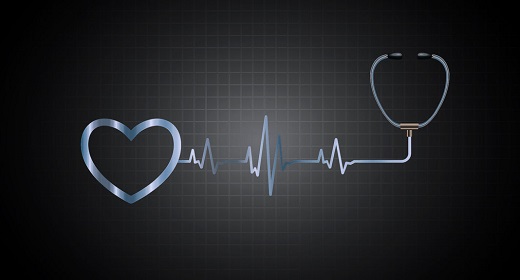by Peter H. Diamandis, MD: Increasing your healthspan (i.e. making 100 years old the new 60) will depend to a large degree on artificial intelligence…
And, as we saw in last week’s blog, healthcare AI systems are extremely data-hungry.
Fortunately, a slew of new sensors and data acquisition methods—including over 122 million wearables shipped in 2018—are bursting onto the scene to meet the massive demand for medical data.
From ubiquitous biosensors, to the mobile healthcare revolution, to the transformative power of the Health Nucleus, converging exponential technologies are fundamentally transforming our approach to healthcare.
In Part 4 of this blog series on Longevity & Vitality, I expand on how we’re acquiring the data to fuel today’s AI healthcare revolution.
In this blog, I’ll explore:
- How the Health Nucleus is transforming “sick care” to healthcare
- Sensors, wearables, and nanobots
- The advent of mobile health
Let’s dive in.
Health Nucleus: Transforming ‘Sick Care’ to Healthcare
Much of today’s healthcare system is actually sick care. Most of us assume that we’re perfectly healthy, with nothing going on inside our bodies, until the day we travel to the hospital writhing in pain only to discover a serious or life-threatening condition.
Chances are that your ailment didn’t materialize that morning; rather, it’s been growing or developing for some time. You simply weren’t aware of it. At that point, once you’re diagnosed as “sick,” our medical system engages to take care of you.
What if, instead of this retrospective and reactive approach, you were constantly monitored, so that you could know the moment anything was out of whack?
Better yet, what if you more closely monitored those aspects of your body that your gene sequence predicted might cause you difficulty? Think: your heart, your kidneys, your breasts. Such a system becomes personalized, predictive, and possibly preventative.
This is the mission of the Health Nucleus platform built by Human Longevity, Inc. (HLI). While not continuous—that will come later, with the next generation of wearable and implantable sensors—the Health Nucleus was designed to ‘digitize’ you once per year to help you determine whether anything is going on inside your body that requires immediate attention.
The Health Nucleus visit provides you with the following tests during a half-day visit:
- Whole genome sequencing (30x coverage)
- Whole body (non-contrast) MRI
- Brain magnetic resonance imaging/angiography (MRI/MRA)
- CT (computed tomography) of the heart and lungs
- Coronary artery calcium scoring
- Electrocardiogram
- Echocardiogram
- Continuous cardiac monitoring
- Clinical laboratory tests and metabolomics
In late 2018, HLI published the results of the first 1,190 clients through the Health Nucleus. The results were eye-opening—especially since these patients were all financially well-off, and already had access to the best doctors.
Following are the physiological and genomic findings in these clients who self-selected to undergo evaluation at HLI’s Health Nucleus.
Physiological Findings [TG]
- Two percent had previously unknown tumors detected by MRI
- 2.5 percent had previously undetected aneurysms detected by MRI
- Eight percent had cardiac arrhythmia found on cardiac rhythm monitoring, not previously known
- Nine percent had moderate-severe coronary artery disease risk, not previously known
- 16 percent discovered previously unknown cardiac structure/function abnormalities
- 30 percent had elevated liver fat, not previously known
Genomic Findings [TG]
- 24 percent of clients uncovered a rare (unknown) genetic mutation found on WGS
- 63 percent of clients had a rare genetic mutation with a corresponding phenotypic finding
In summary, HLI’s published results found that 14.4 percent of clients had significant findings that are actionable, requiring immediate or near-term follow-up and intervention.
Long-term value findings were found in 40 percent of the clients we screened. Long-term clinical findings include discoveries that require medical attention or monitoring but are not immediately life-threatening.
The bottom line: most people truly don’t know their actual state of health. The ability to take a fully digital deep dive into your health status at least once per year will enable you to detect disease at stage zero or stage one, when it is most curable.
Sensors, Wearables, and Nanobots
Wearables, connected devices, and quantified self apps will allow us to continuously collect enormous amounts of useful health information.
Wearables like the Quanttus wristband and Vital Connect can transmit your electrocardiogram data, vital signs, posture, and stress levels anywhere on the planet.
In April 2017, we were proud to grant $2.5 million in prize money to the winning team in the Qualcomm Tricorder XPRIZE, Final Frontier Medical Devices.
Using a group of noninvasive sensors that collect data on vital signs, body chemistry, and biological functions, Final Frontier integrates this data in their powerful, AI-based DxtER diagnostic engine for rapid, high-precision assessments.
Their engine combines learnings from clinical emergency medicine and data analysis from actual patients.
Google is developing a full range of internal and external sensors (e.g. smart contact lenses) that can monitor the wearer’s vitals, ranging from blood sugar levels to blood chemistry.
In September 2018, Apple announced its Series 4 Apple Watch, including an FDA-approved mobile, on-the-fly ECG. Granted its first FDA approval, Apple appears to be moving deeper into the sensing healthcare market.
Further, Apple is reportedly now developing sensors that can non-invasively monitor blood sugar levels in real time for diabetic treatment. IoT-connected sensors are also entering the world of prescription drugs.
Last year, the FDA approved the first sensor-embedded pill, Abilify MyCite. This new class of digital pills can now communicate medication data to a user-controlled app, to which doctors may be granted access for remote monitoring.
Perhaps what is most impressive about the next generation of wearables and implantables is the density of sensors, processing, networking, and battery capability that we can now cheaply and compactly integrate.
Take the second-generation OURA ring, for example, which focuses on sleep measurement and management.
The OURA ring looks like a slightly thick wedding band, yet contains an impressive array of sensors and capabilities, including:
- Two infrared LED
- One infrared sensor
- Three temperature sensors
- One accelerometer
- A six-axis gyro
- A curved battery with a seven-day life
- The memory, processing, and transmission capability required to connect with your smartphone
Disrupting Medical Imaging Hardware
In 2018, we saw lab breakthroughs that will drive the cost of an ultrasound sensor to below $100, in a packaging smaller than most bandages, powered by a smartphone. Dramatically disrupting ultrasound is just the beginning.
Nanobots and Nanonetworks
While wearables have long been able to track and transmit our steps, heart rate, and other health data, smart nanobots and ingestible sensors will soon be able to monitor countless new parameters and even help diagnose disease.
Some of the most exciting breakthroughs in smart nanotechnology from the past year include:
- Researchers from the École Polytechnique Fédérale de Lausanne (EPFL) and the Swiss Federal Institute of Technology in Zurich (ETH Zurich) demonstrated artificial microrobots that can swim and navigate through different fluids, independent of additional sensors, electronics, or power transmission.
- Researchers at the University of Chicago proposed specific arrangements of DNA-based molecular logic gates to capture the information contained in the temporal portion of our cells’ communication mechanisms. Accessing the otherwise-lost time-dependent information of these cellular signals is akin to knowing the tune of a song, rather than solely the lyrics.
- MIT researchers built micron-scale robots able to sense, record, and store information about their environment. These tiny robots, about 100 micrometers in diameter (approximately the size of a human egg cell), can also carry out pre-programmed computational tasks.
- Engineers at University of California, San Diego developed ultrasound-powered nanorobots that swim efficiently through your blood, removing harmful bacteria and the toxins they produce.
But it doesn’t stop there.
As nanosensor and nanonetworking capabilities develop, these tiny bots may soon communicate with each other, enabling the targeted delivery of drugs and autonomous corrective action.
Mobile Health
The OURA ring and the Series 4 Apple Watch are just the tip of the spear when it comes to our future of mobile health. This field, predicted to become a $102 billion market by 2022, puts an on-demand virtual doctor in your back pocket.
Step aside, WebMD.
In true exponential technology fashion, mobile device penetration has increased dramatically, while image recognition error rates and sensor costs have sharply declined.
As a result, AI-powered medical chatbots are flooding the market; diagnostic apps can identify anything from a rash to diabetic retinopathy; and with the advent of global connectivity, mHealth platforms enable real-time health data collection, transmission, and remote diagnosis by medical professionals.
Already available to residents across North London, Babylon Health offers immediate medical advice through AI-powered chatbots and video consultations with doctors via its app.
Babylon now aims to build up its AI for advanced diagnostics and even prescription. Others, like Woebot, take on mental health, using cognitive behavioral therapy in communications over Facebook messenger with patients suffering from depression.
In addition to phone apps and add-ons that test for fertility or autism, the now-FDA-approved Clarius L7 Linear Array Ultrasound Scanner can connect directly to iOS and Android devices and perform wireless ultrasounds at a moment’s notice.
Next, Healthy.io, an Israeli startup, uses your smartphone and computer vision to analyze traditional urine test strips—all you need to do is take a few photos.
With mHealth platforms like ClickMedix, which connects remotely-located patients to medical providers through real-time health data collection and transmission, what’s to stop us from delivering needed treatments through drone delivery or robotic telesurgery?
Welcome to the age of smartphone-as-a-medical-device.
Conclusion
With these DIY data collection and diagnostic tools, we save on transportation costs (time and money), and time bottlenecks.
No longer will you need to wait for your urine or blood results to go through the current information chain: samples will be sent to the lab, analyzed by a technician, results interpreted by your doctor, and only then relayed to you.
Just like the “sage-on-the-stage” issue with today’s education system, healthcare has a “doctor-on-the-dais” problem. Current medical procedures are too complicated and expensive for a layperson to perform and analyze on their own.
The coming abundance of healthcare data promises to transform how we approach healthcare, putting the power of exponential technologies in the patient’s hands and revolutionizing how we live.









































